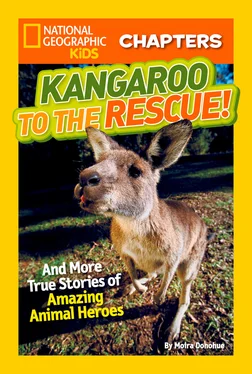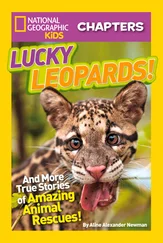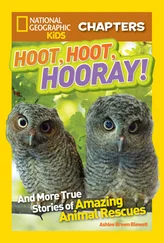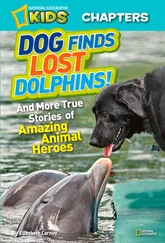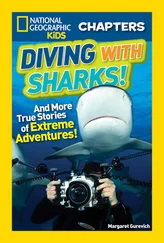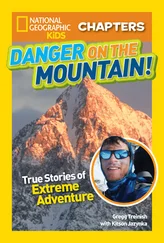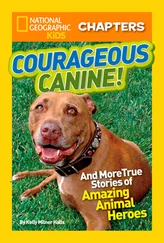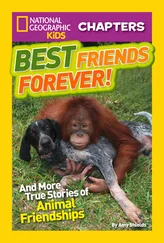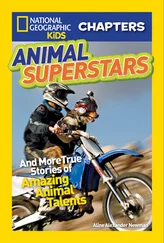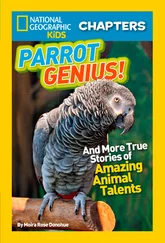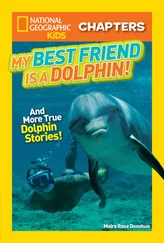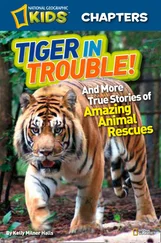Moira Donohue - National Geographic Kids Chapters - Kangaroo to the Rescue! - And More True Stories of Amazing Animal Heroes
Здесь есть возможность читать онлайн «Moira Donohue - National Geographic Kids Chapters - Kangaroo to the Rescue! - And More True Stories of Amazing Animal Heroes» — ознакомительный отрывок электронной книги совершенно бесплатно, а после прочтения отрывка купить полную версию. В некоторых случаях можно слушать аудио, скачать через торрент в формате fb2 и присутствует краткое содержание. Жанр: unrecognised, на английском языке. Описание произведения, (предисловие) а так же отзывы посетителей доступны на портале библиотеки ЛибКат.
- Название:National Geographic Kids Chapters: Kangaroo to the Rescue!: And More True Stories of Amazing Animal Heroes
- Автор:
- Жанр:
- Год:неизвестен
- ISBN:нет данных
- Рейтинг книги:5 / 5. Голосов: 1
-
Избранное:Добавить в избранное
- Отзывы:
-
Ваша оценка:
- 100
- 1
- 2
- 3
- 4
- 5
National Geographic Kids Chapters: Kangaroo to the Rescue!: And More True Stories of Amazing Animal Heroes: краткое содержание, описание и аннотация
Предлагаем к чтению аннотацию, описание, краткое содержание или предисловие (зависит от того, что написал сам автор книги «National Geographic Kids Chapters: Kangaroo to the Rescue!: And More True Stories of Amazing Animal Heroes»). Если вы не нашли необходимую информацию о книге — напишите в комментариях, мы постараемся отыскать её.
National Geographic Kids Chapters: Kangaroo to the Rescue!: And More True Stories of Amazing Animal Heroes — читать онлайн ознакомительный отрывок
Ниже представлен текст книги, разбитый по страницам. Система сохранения места последней прочитанной страницы, позволяет с удобством читать онлайн бесплатно книгу «National Geographic Kids Chapters: Kangaroo to the Rescue!: And More True Stories of Amazing Animal Heroes», без необходимости каждый раз заново искать на чём Вы остановились. Поставьте закладку, и сможете в любой момент перейти на страницу, на которой закончили чтение.
Интервал:
Закладка:
“They brought home a lot of king parrots that were hurt,” said their father, Len. Once Luke and Celeste found a wounded opossum. They even rescued a wombat. They brought them to their father. He showed them how to nurse the animals.
But a baby kangaroo was another story. This joey was a female. She was about three months old. Normally, a joey doesn’t even peek out of its pouch until it is four months old. At five or six months, it climbs out into the world. But only for a short time. After a few minutes, the joey dives headfirst back into the pouch. The joey doesn’t leave the pouch for good until it’s about ten months old.
This joey would need a lot of care. Luke’s parents wondered if he would have enough time to take care of her.
“I want to do it,” Luke told them. His mother and father discussed it. They were proud of him for wanting to take care of the roo. Len and Lynn decided to give him a chance.
Lynn found an old sleeping bag. She cut it up. She sewed a pouch for the baby kangaroo. Luke slipped the joey in. She seemed to like it. It was more like a mother’s pouch than Luke’s sweater had been.
Next, Luke tried to feed the joey milk from a bottle. She refused.

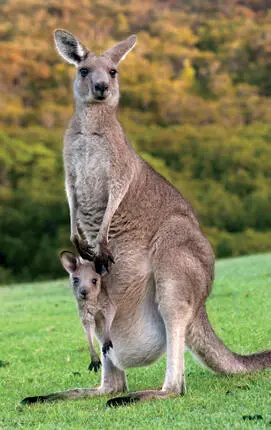
( photo credit 1.1)
Marsupials are mammals, like dogs and people. Like most mammals, they give birth to live babies. But marsupials are different from other mammals in one big way. Marsupial females have pouches. When they give birth, their babies are very tiny. A newborn kangaroo is about the size of a grape!
Right after birth, a marsupial baby crawls into its mother’s pouch. The mother carries her babies in her pouch for months. Most of the marsupials in the world live in Australia. The largest marsupial is the red kangaroo. Koalas and wombats are also marsupials.
Poor baby. She was probably missing her mother’s milk. But Luke didn’t give up. And after a couple of days, the joey finally drank the milk. Now that she was drinking milk, Luke had to feed her often—even in the middle of the night.
After taking the bottle for a while, the joey suddenly stopped. Maybe she’s ready for real food, Luke thought. He knew that kangaroos eat tender leaves and grass. Luke pulled up some grass and put it in his room.
The next morning, Len heard his son call out, “She’s eating grass!” The joey was growing up.
Luke continued to take care of the little roo. His family helped. They held her, petted her, and snuggled her. She cuddled with them on the couch. They were growing very attached to her.
But after a few months, the Richards family had another discussion.
“I think it’s time we turned the joey out,” Len said. He knew she needed to return to the wild.
No one wanted to see her go. She was a family pet now. But they agreed it was the right thing to do. The next morning, Len opened the gate. The family watched silently as the joey hopped through it. She bounded over the next fence. She bounced high over the next one.
She was gone.
But three hours later, something was hopping around the Richardses’ yard. The joey was back!
In the Richardses’ backyard, Lulu perks up her big ears. ( photo credit 1.2)
The Richardses were thrilled to have the joey back. But if she was going to stay, they needed to make some changes.
Len said, “She needs a name.” They had another family discussion. No one said anything at first.
“What about ‘Lulu’?” Lynn asked. Everyone liked the name right away. Then Lynn said, “She needs to move outside.”
The joey wasn’t housebroken. Lynn was tired of the messes Lulu made in the house. She thought if she hung a cloth pouch on the porch, Lulu could hop in and out during the night. Then Luke wouldn’t have to cover his floor with newspapers.
Lulu seemed to like the idea right away. She had a little freedom. But she had her family close by, too.
The joey grew. During the day, she roamed freely around the farm. The Richardses had an apple tree on the farm. King parrots liked to perch in the tree. They munched on the fresh, crunchy apples.
But Lulu wanted the crisp apples, too. She would jump up and scare the birds away. Then she would pull the ripest apples off the tree for herself.
Sometimes Lulu hopped the fences and took off for the bush. But at six in the evening, the Richardses would hear a loud banging on the door. Lulu kicked the door with her feet at dinnertime every night. Then she bounded inside the house. Lulu headed to the pantry first. She wanted a snack of her favorite “teddy bear” biscuits (sounds like BIS-kits), or cookies.
Did You Know?
Female kangaroos are called “flyers.” The males are called “boomers.”
She reached for the snack jar with her front paws. Kangaroos are one of very few bipedal (sounds like bye-PED-ul) animals. That means that they walk on two feet, like humans. They use their front paws to hold things. They also use them if they are walking on all fours, called “slow walking.”
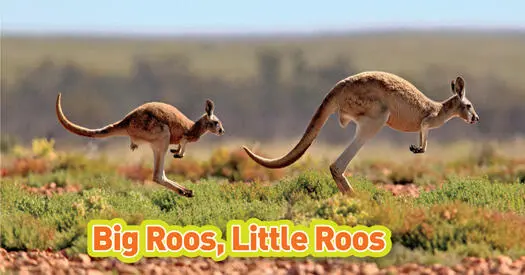
( photo credit 2.1)
There are millions of kangaroos in Australia. In fact, more kangaroos live there than people! There are more than 60 kinds, or species (sounds like SPEE-sheez), of kangaroo. They come in many sizes. The two largest kinds are gray kangaroos and red kangaroos (shown above). They can stand as tall as a six-foot (1.8-m) person and usually weigh 120 to 150 pounds (54 to 68 kg). They live in herds called “mobs.” The smallest kangaroo is the musky rat kangaroo. It’s only about the size of—you guessed it—a rat.
“Lulu, be careful,” Len would tell the roo. But a few times he didn’t get there fast enough, and Lulu dropped the jar. After she broke a couple of jars, Len got a plastic box for the biscuits.
The Richardses kept a big bowl of fruit for the family. It usually sat on the dinner table. Lulu loved fruit. She stood high on her back legs. She stretched out her front paws to grab the bowl. But if she couldn’t reach it, Lulu knew a clever trick.
Slowly she tugged the tablecloth. Bit by bit, the bowl moved closer. Then Lulu picked through the fruit. She especially liked nectarines (sounds like nek-tuh-REENS) and bananas. But she wanted the ripest fruit. If she bit into a piece that wasn’t ripe enough, she put it back and took another! Then she held the fruit with her front paws and nibbled around the pit.
The Richardses also had a dog. Bustie was a cocker spaniel (sounds like SPANyul). Lulu liked to play with Bustie. She chased him. She batted at him with her front paws. She even grabbed his silky ears. He didn’t mind. And sometimes he played with her, too.
Lulu sat with the family and Bustie in the living room every evening. Like most dogs, Bustie liked to lay by the fireplace. Lulu liked it there, too. If Bustie was already curled up in front of the fire, Lulu would nudge him out of the way. After all, she was a lot bigger. Then Lulu would lay down with her front legs under her. As she relaxed, her head went down and her paws went out. Soon she was asleep.
“That’s how I knew she really trusted us,” said Len.
The Richardses never tried to train Lulu to go to the bathroom outside, like a dog. Somehow, she just figured it out. Whenever she wanted to go outside, she went to the door and stood there. If they didn’t notice right away, she knocked on it.
Читать дальшеИнтервал:
Закладка:
Похожие книги на «National Geographic Kids Chapters: Kangaroo to the Rescue!: And More True Stories of Amazing Animal Heroes»
Представляем Вашему вниманию похожие книги на «National Geographic Kids Chapters: Kangaroo to the Rescue!: And More True Stories of Amazing Animal Heroes» списком для выбора. Мы отобрали схожую по названию и смыслу литературу в надежде предоставить читателям больше вариантов отыскать новые, интересные, ещё непрочитанные произведения.
Обсуждение, отзывы о книге «National Geographic Kids Chapters: Kangaroo to the Rescue!: And More True Stories of Amazing Animal Heroes» и просто собственные мнения читателей. Оставьте ваши комментарии, напишите, что Вы думаете о произведении, его смысле или главных героях. Укажите что конкретно понравилось, а что нет, и почему Вы так считаете.
